Website Design for Construction Companies
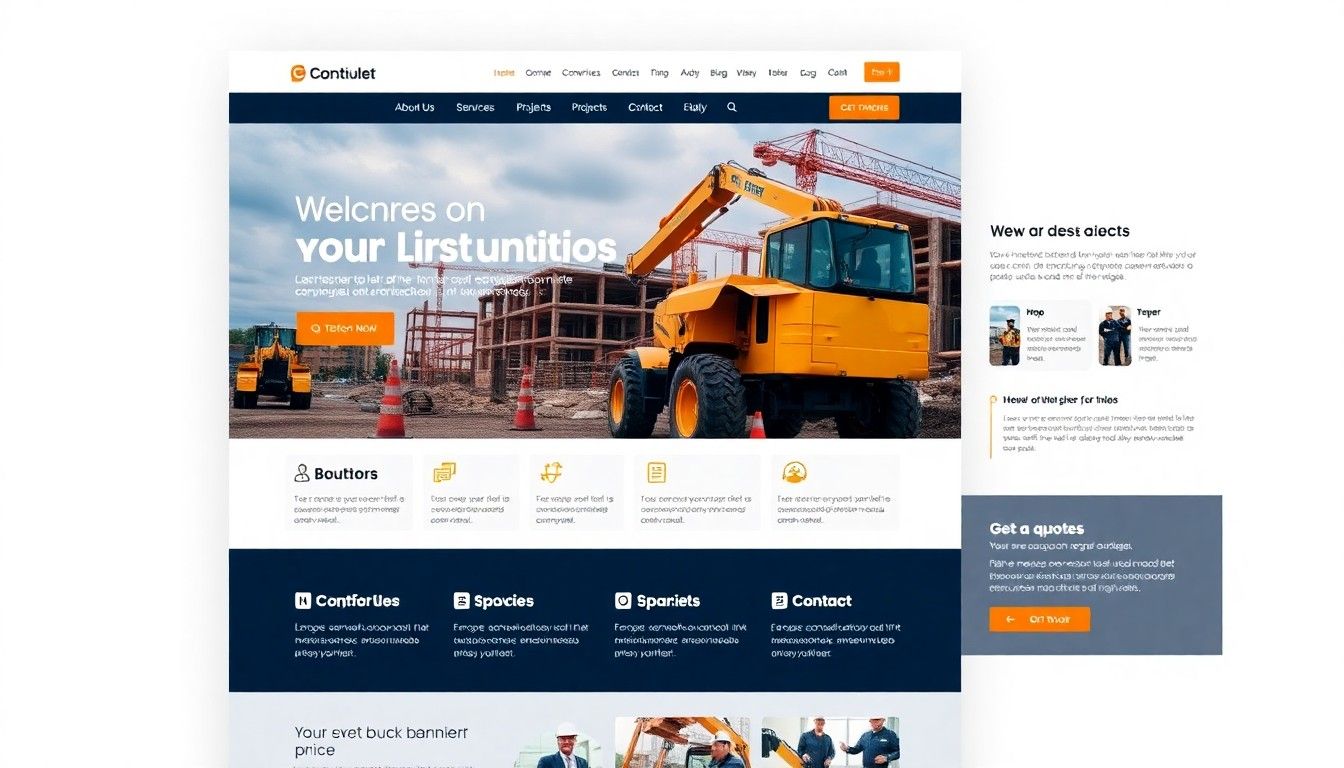
How to Build a Site That Attracts Clients and Boosts Business
If you're a construction company owner scrolling through competitor websites at 2 AM wondering why their sites look like they were built this century while yours looks like it time-traveled from 1995, you're not alone! (We've all been there - no judgment here.)
The truth is, your website is often the first impression potential clients get of your business, and in an industry where trust equals contracts, that first impression better be rock-solid.
Here's the thing - construction companies face unique challenges when it comes to web design. You need to showcase massive projects that span months or years, build trust with homeowners who are making their biggest investment, and compete with companies that might have deeper pockets for marketing.
But here's some good news: you don't need to break the bank to create a website that turns visitors into clients.
We're going to walk through real examples of construction websites that nail the balance between professional credibility and user-friendly design.
You'll see exactly what works (and what doesn't), plus get actionable insights you can apply whether you're building from scratch or giving your current site a much-needed makeover. Think of this as your digital blueprint for construction website success!
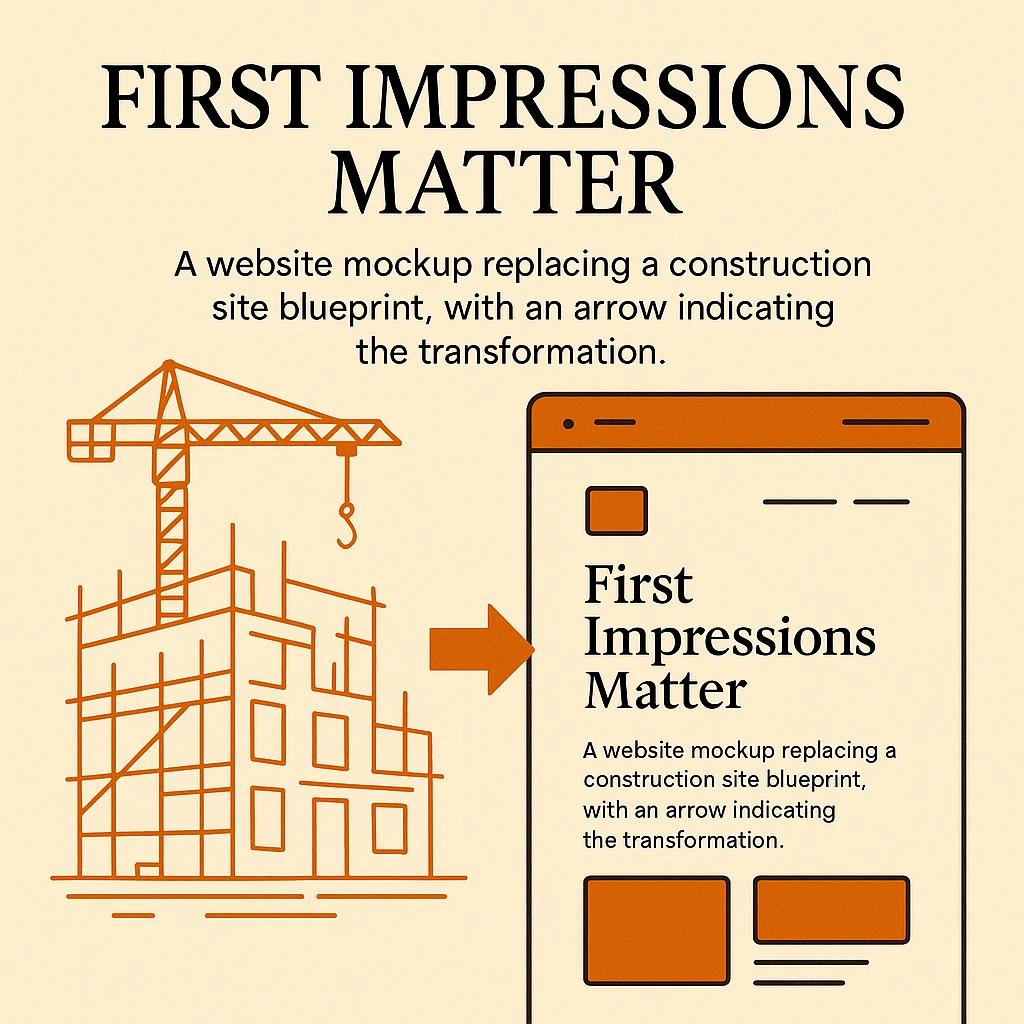
Visual Design Elements That Build Trust and Credibility
When someone lands on your construction website, they're not just browsing - they're evaluating whether you're the right team to handle their dream home renovation or commercial project. The visual elements you choose can make or break that crucial first impression. Let's look at what the best construction websites are doing right.
Clean, professional layouts with plenty of whitespace help visitors focus on what matters most: your work. Take Jerdon Construction's approach - their homepage immediately communicates their commercial construction specialty with clear messaging and strategically placed calls-to-action (Source: Network Solutions).
This isn't about flashy graphics or complex animations; it's about creating a sense of reliability and expertise.
High-quality project photos are absolutely non-negotiable. Edifis showcases their industrial projects with bold visuals that include key details like project size and completion dates, adding instant credibility (Source: Network Solutions). These details matter because they show you're organized, professional, and proud of your work.
If you're wondering about the technical side of creating stunning visuals, our guide to small business website design covers the fundamentals that apply perfectly to construction companies.
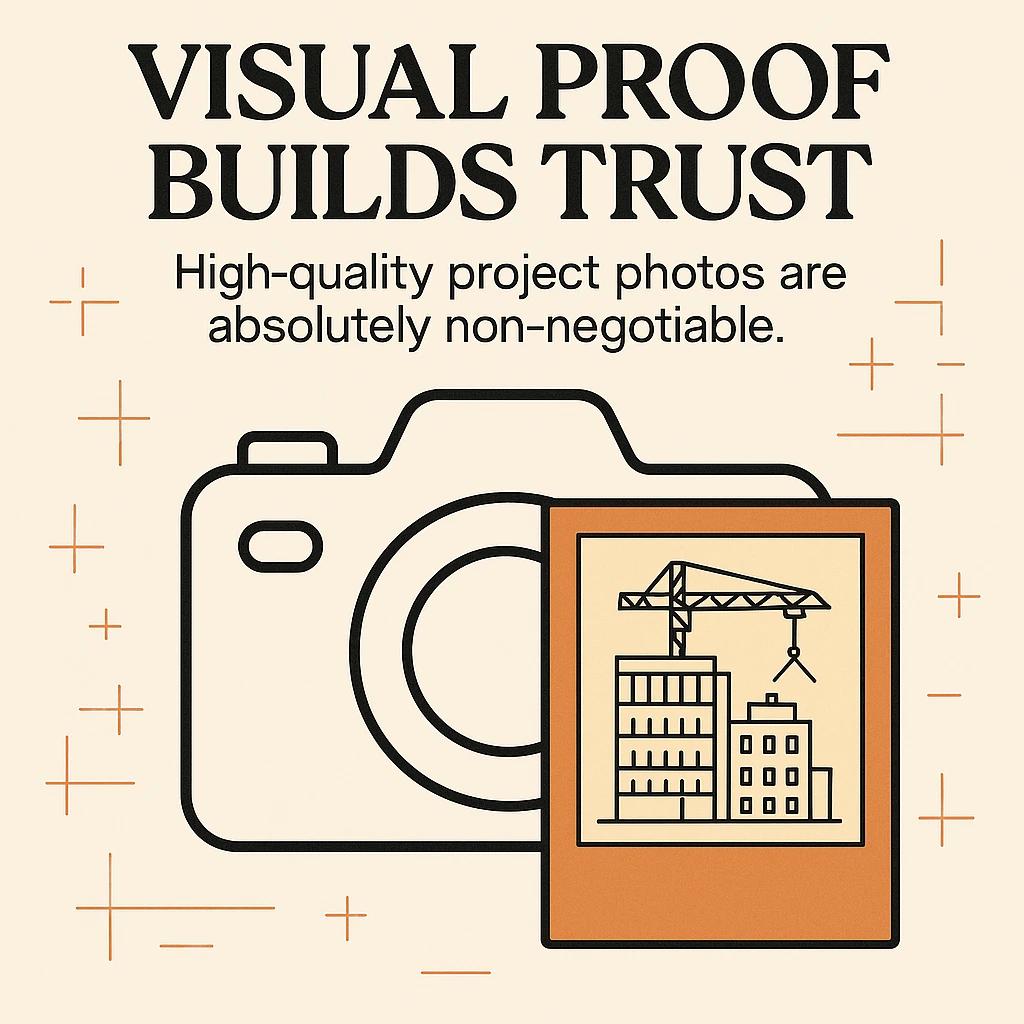
Project Photos
- Purpose: Showcase quality of work
- Best Practice: Include before/after, completion stats, location details
Color Scheme
- Purpose: Reflect brand personality
- Best Practice: Use 2-3 primary colors that convey trust and professionalism
Typography
- Purpose: Enhance readability
- Best Practice: Choose clean, professional fonts that work on mobile devices
Whitespace
- Purpose: Improve focus and clarity
- Best Practice: Balance content with breathing room for better user experience
The Power of Client Testimonials
Both Jerdon Construction and Edifis feature client testimonials prominently throughout their sites, and there's a reason for that - social proof is incredibly powerful in the construction industry (Source: Network Solutions). When someone is considering investing thousands or even hundreds of thousands of dollars in a construction project, they want to know that others have had positive experiences with your company.
The key is making testimonials feel authentic and specific. Instead of generic "Great work!" quotes, showcase testimonials that mention specific aspects of your service, timeline adherence, or problem-solving abilities.
Video testimonials from happy clients standing in front of their completed projects are even more powerful - they provide both credibility and emotional connection.

User Experience Features That Convert Visitors into Leads
Creating a beautiful construction website is only half the battle - you need to make it easy for potential clients to find what they're looking for and take action. The best construction websites understand that user experience isn't just about looking good; it's about guiding visitors toward becoming leads.
Project showcases with detailed information are essential for construction companies. When visitors can see completed projects with descriptions, dates, and locations, they can better visualize your capabilities (Source: Network Solutions). This approach works because it addresses the biggest question in every potential client's mind: "Can they handle my project?"
Interactive elements like before-and-after sliders are particularly effective for construction sites. American Concrete Leveling uses these sliders to demonstrate work quality visually, which is incredibly powerful for conversion (Source: WebCitz).
There's something satisfying about sliding between a cracked, uneven surface and a perfectly smooth, professional finish - it tells the whole story without words.
Project Galleries
- Impact on Conversion: Builds confidence in capabilities
- Implementation Tip: Organize by project type and include completion details
Before/After Sliders
- Impact on Conversion: Demonstrates transformation value
- Implementation Tip: Use high-quality images with consistent lighting
Service Pages
- Impact on Conversion: Clarifies offerings and expertise
- Implementation Tip: Include pricing ranges and typical timelines
Contact Forms
- Impact on Conversion: Captures lead information
- Implementation Tip: Keep forms short but ask for project details
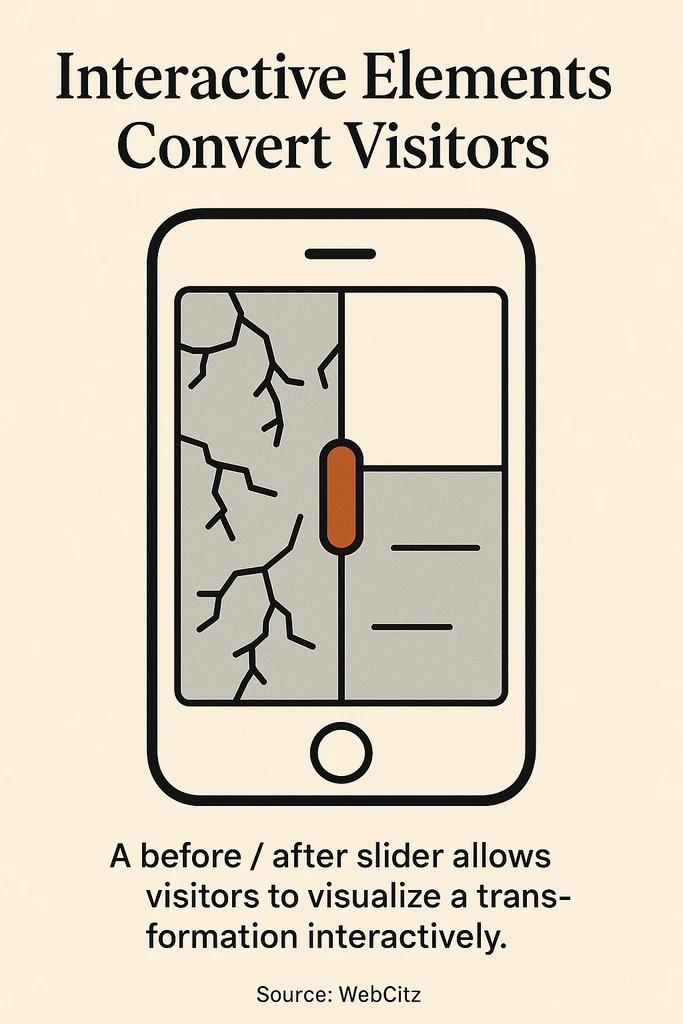
Navigation That Works for Construction Companies
Construction websites need navigation that reflects how clients actually think about your services. Ayers Basement Systems includes a search bar for easy access to specific content, which is smart because construction can involve complex technical topics (Source: WebCitz). Clear, well-labeled navigation helps users find services quickly without frustration.
Consider organizing your navigation around client needs rather than internal business structure. Instead of "Services," try "Home Renovation," "Commercial Construction," or "Emergency Repairs." This approach immediately tells visitors whether you can help with their specific situation. For more detailed guidance on creating intuitive navigation, check out our article on website navigation design.
Strategic Call-to-Action Placement for Maximum Impact
Here's where many construction websites miss the mark - they assume visitors will magically know what to do next. The reality is that effective call-to-action (CTA) placement can make the difference between a visitor who browses and leaves, and one who becomes a paying client.
Prominent CTAs like "Get a Quote," "Contact Us," or "Start the Conversation" should be placed strategically throughout your site, not just buried in the footer (Source: Hook Agency). The key is balance - you want to guide users toward conversion without overwhelming them with pushy sales tactics.
Jerdon Construction does this well by placing CTAs strategically but sparingly throughout their site (Source: Network Solutions). Each CTA feels natural and helpful rather than desperate. This approach builds trust while gently encouraging action.
Header/Hero Section
- Purpose: Immediate engagement
- Best Practice: Use action-oriented language like "Get Your Free Estimate"
Project Gallery
- Purpose: Convert inspired visitors
- Best Practice: "Ready to start your project?" with contact form
Service Pages
- Purpose: Capture interested prospects
- Best Practice: "Schedule a consultation" or "Get a custom quote"
Footer
- Purpose: Last chance conversion
- Best Practice: Phone number and emergency contact information
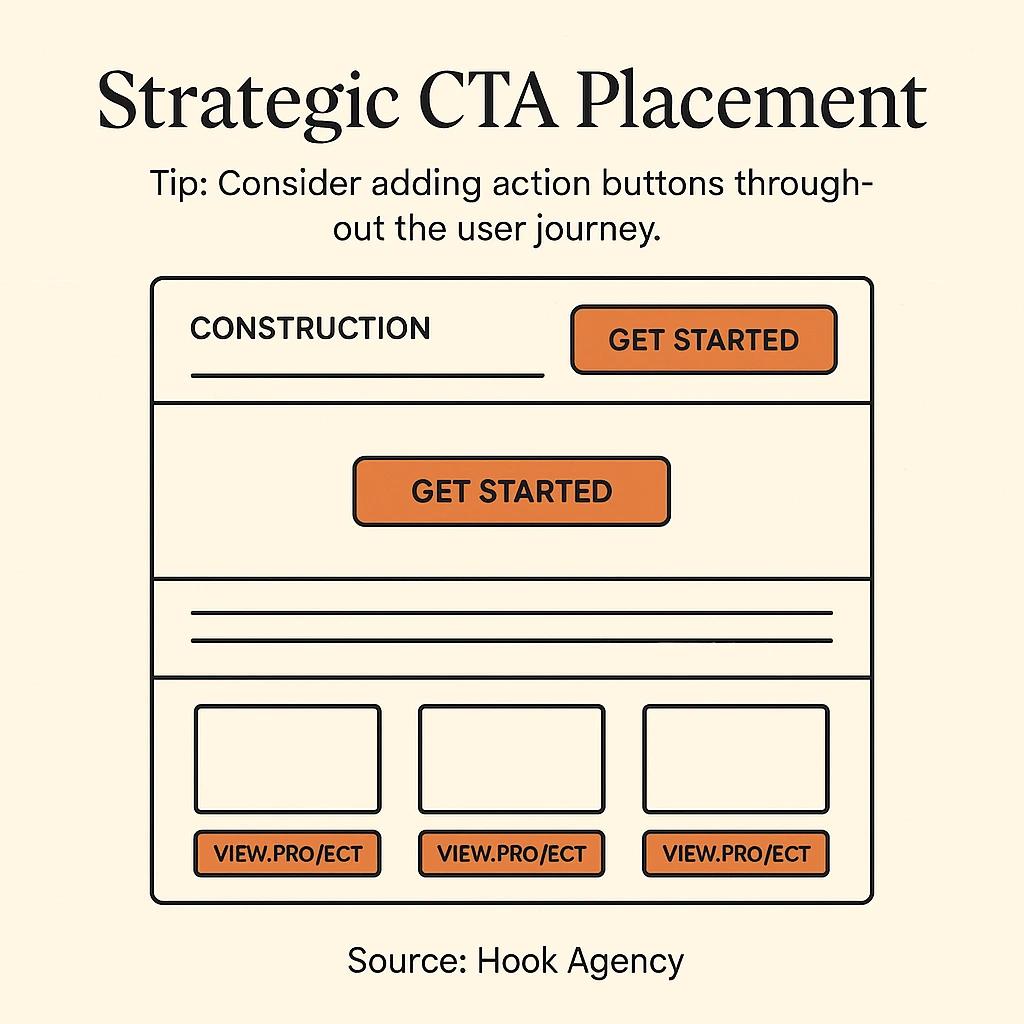
The Psychology Behind Effective CTAs
Construction projects often involve significant financial and emotional investment, which means your CTAs need to address both practical and psychological barriers. Instead of generic "Contact Us" buttons, try CTAs that acknowledge the decision-making process: "Get Your Free Consultation" or "See If We're a Good Fit." These phrases feel less pushy and more collaborative.
Multiple CTAs spaced throughout your pages work better than one big push at the end. This approach recognizes that visitors might be ready to take action at different points in their journey. Someone might want to call after seeing your project gallery, while another visitor might need to read testimonials first.
When you're ready to optimize your CTAs for better conversion, our guide on writing effective website copy that converts has proven strategies you can implement immediately.
Mobile Responsiveness: Why It's Critical for Construction Companies
Here's a reality check: a significant portion of your potential clients are browsing construction websites on their phones. Maybe they're stuck in traffic thinking about their kitchen renovation, or they're at a job site researching contractors for their next project. If your website doesn't work seamlessly on mobile devices, you're literally losing money every day.
Modern website templates and platforms emphasize mobile responsiveness without requiring coding expertise. This is crucial because mobile traffic continues to grow, and search engines like Google prioritize mobile-friendly websites in their rankings (Source: Astra Templates).
The good news is that mobile optimization isn't just about technical requirements - it's about user experience.
Mobile-responsive construction websites need to prioritize essential information and actions. Your phone number should be tap-to-call, your contact form should be easy to fill out with thumbs, and your project photos should load quickly even on slower connections.
These details might seem minor, but they're the difference between a frustrated visitor who leaves and one who becomes a client.
- Ensure project photos load quickly and display clearly on small screens
- Make contact information easily accessible and tap-to-call enabled
- Simplify navigation menus for thumb-friendly browsing
- Optimize forms for mobile input with appropriate keyboard types
- Test loading speed on actual mobile devices, not just desktop browsers
The Technical Side Made Simple
You don't need to become a web developer to ensure your construction website works well on mobile devices. Many modern website builders handle responsive design automatically, but you should still test your site on actual phones and tablets. Ask friends, family, or current clients to browse your site on their devices and give you honest feedback.
Pay special attention to how your project galleries display on mobile. Large, high-resolution photos that look stunning on desktop can be slow to load and difficult to navigate on phones. Consider using image optimization tools or working with a web design professional who understands the construction industry's unique needs.
Content Strategy That Resonates with Construction Clients
The best construction websites don't just showcase pretty pictures - they tell stories that help potential clients envision their own projects. Your content strategy should address the questions, concerns, and dreams that keep your ideal clients up at night (in a good way!).
Industry-specific language combined with straightforward messaging builds clarity and trust. You want to demonstrate expertise without overwhelming visitors with technical jargon they don't understand. The goal is to sound knowledgeable and professional while remaining accessible to homeowners and business owners who might not know the difference between a joist and a beam.
Including FAQ sections on service pages addresses common customer concerns upfront, reducing friction in the decision-making process (Source: Hook Agency). These sections are incredibly valuable because they handle objections and questions before they become barriers to hiring you.
Project Case Studies
- Purpose: Demonstrate problem-solving abilities
- Example Topics: "How we solved this client's foundation issue"
Process Explanations
- Purpose: Reduce client anxiety
- Example Topics: "What to expect during your kitchen renovation"
FAQ Sections
- Purpose: Address common concerns
- Example Topics: "Do you provide cleanup?" "How long will it take?"
Client Stories
- Purpose: Build emotional connection
- Example Topics: "From cramped to spacious: A family's transformation"
The Art of Construction Storytelling
Every construction project has a story - the challenge, the solution, and the transformation. Incorporating storytelling through photos and descriptions of happy clients adds emotional appeal beyond technical specifications (Source: Hook Agency). Instead of just showing before and after photos, tell the story of why the project mattered to the client.
For example, instead of "Kitchen renovation completed in 6 weeks," try "Sarah's growing family needed a kitchen that could handle homework, meal prep, and quality time together. Here's how we created a space that works for their busy lifestyle."
This approach helps visitors imagine their own transformation story. If you're looking for more guidance on creating compelling content that connects with your audience, our resource on choosing a web design agency includes insights on content strategy that can transform your construction company's online presence.
Learning from the Best: Construction Website Examples That Work
Sometimes the best way to understand effective construction website design is to see it in action. We've analyzed dozens of construction websites to identify the patterns and strategies that consistently drive results. Here are the standout examples that every construction company can learn from.
Jerdon Construction's website immediately communicates their commercial construction specialty with clear messaging and well-placed calls-to-action (Source: Network Solutions). What makes their approach especially effective is how they balance professional credibility with approachability - you get the sense that they're experts who are also easy to work with.
Edifis takes a different but equally effective approach with bold visuals and project statistics that add instant credibility (Source: Network Solutions). Their industrial project showcase includes completion dates, project sizes, and locations - details that matter to potential clients evaluating capabilities.
Jerdon Construction
- Key Strengths: Clear service focus, strategic CTAs, client testimonials
- What You Can Apply: Immediate specialization clarity, trust-building elements
Edifis
- Key Strengths: Bold visuals, project statistics, newsletter signup
- What You Can Apply: Credibility through data, ongoing client engagement
Ayers Basement Systems
- Key Strengths: Unique branding, search functionality, marketing focus
- What You Can Apply: Distinctive identity, user-friendly navigation
American Concrete Leveling
- Key Strengths: Before/after sliders, strong branding, visual proof
- What You Can Apply: Interactive elements, transformation storytelling
What Makes These Examples Stand Out
American Concrete Leveling's use of before-and-after image sliders effectively demonstrates work quality visually, which is incredibly powerful for conversion in construction sectors (Source: WebCitz). These interactive elements work because they let visitors control the comparison, making the transformation feel more dramatic and impactful.
Ayers Basement Systems stands out with their unique color palette and search bar functionality, showing that construction websites don't have to look generic (Source: WebCitz). Their marketing-focused approach proves that construction companies can have personality while maintaining professionalism.
Budget-Friendly Ways to Improve Your Construction Website
You don't need to spend a fortune to create a construction website that competes with the big players. Smart, strategic improvements can make a huge difference in how potential clients perceive your business and whether they choose to contact you.
Start with the basics that have the biggest impact: high-quality project photos, clear contact information, and straightforward descriptions of your services. These elements cost more in time than money, but they're often what separates amateur-looking websites from professional ones.
Professional website templates designed specifically for construction companies can provide a solid foundation without custom development costs. The Astra template system offers bright, clean designs with whitespace balance that's perfect for construction companies (Source: Astra Templates). These templates are flexible enough to customize while maintaining professional standards.
- Invest in professional photography of your completed projects
- Write clear, jargon-free descriptions of your services
- Add client testimonials with specific project details
- Create a simple contact form that asks for project information
- Optimize your site for local search with location-specific content
When to Consider Professional Help
While many improvements can be made on a budget, some aspects of construction website design benefit from professional expertise. If you're competing in a crowded market or handling high-value projects, the investment in professional design and development can pay for itself through increased lead quality and conversion rates.
Consider professional help if you need custom functionality like project management portals, complex quote systems, or integration with scheduling software. These features can set you apart from competitors, but they require technical expertise to implement properly. When evaluating whether to invest in professional web design, our comprehensive guide on the benefits of a website redesign can help you understand the potential return on investment for your construction business.
Your Next Steps: Building a Construction Website That Works
You've seen what works, learned from successful examples, and discovered budget-friendly improvements you can implement immediately. Now it's time to take action. The construction industry is competitive, but a well-designed website can be your secret weapon for attracting better clients and growing your business.
Start with an honest assessment of your current website (or lack thereof). Does it clearly communicate what you do and why clients should choose you? Is it easy to navigate on mobile devices? Does it showcase your best work in a way that builds trust and credibility? These fundamental questions will guide your improvement priorities.
The most successful construction websites aren't just digital brochures - they're lead generation machines that work 24/7 to attract and convert potential clients. Whether you're starting from scratch or improving an existing site, focus on the elements that matter most to your target clients: clear communication, visual proof of quality work, and easy ways to get in touch.
Your website is an investment in your business's future. In an industry where word-of-mouth and referrals are still king, a professional online presence amplifies those recommendations and helps you reach clients who might never have found you otherwise. Take the insights from this guide, apply them to your unique situation, and start building the digital foundation your construction company deserves.



